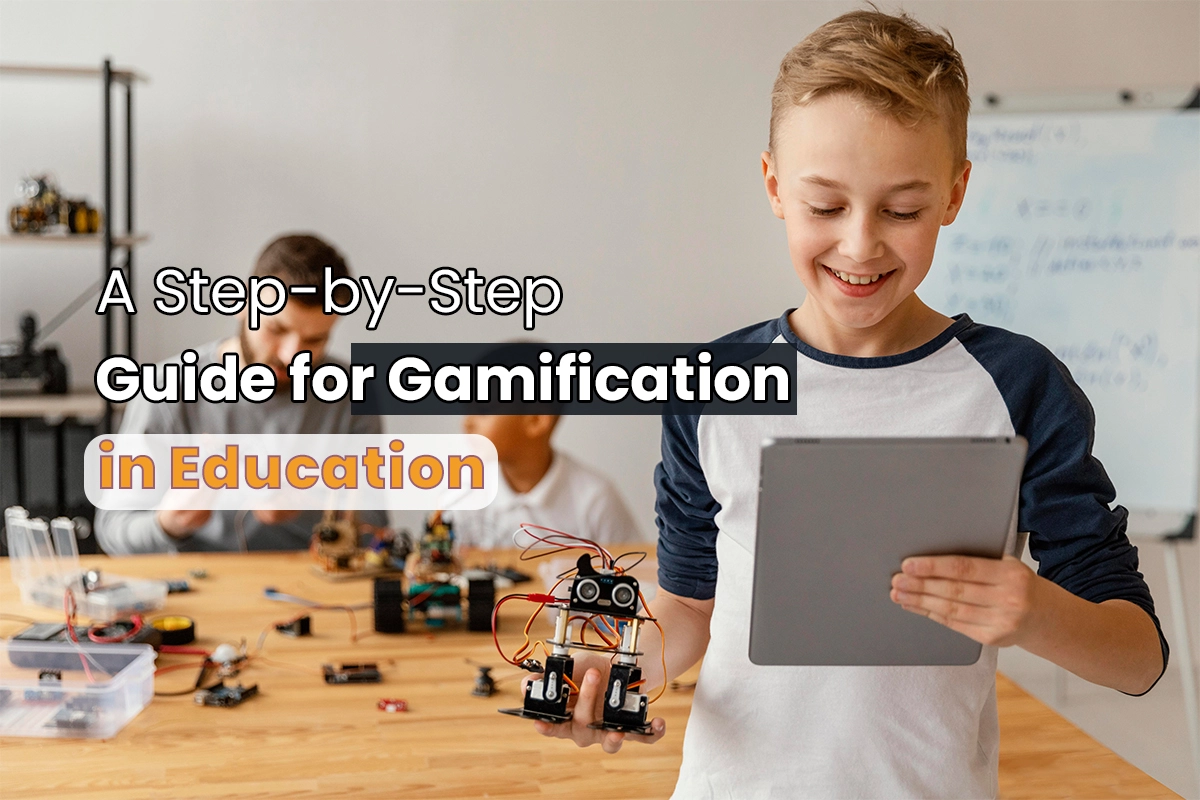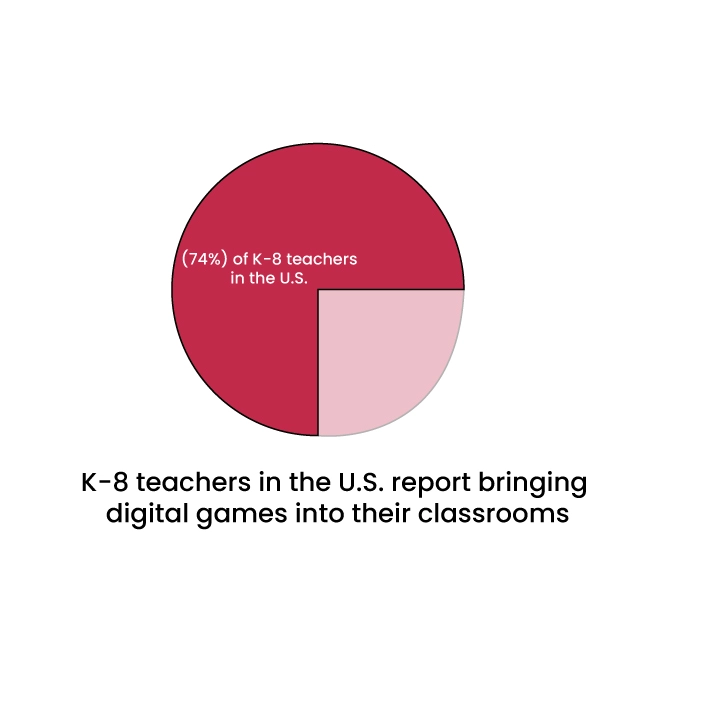
Kids love to play, right? But what if we tell you that they can learn while playing? Suppose your kids are completely engrossed in another world and continue to do so with absolute excitement. The pleasure that sparks on their faces while collecting rewards is priceless; they beat every coming obstacle on their way, and the pressure remains boiling to unlock new levels, find new terrain, and then finally, the bliss of becoming the winner. Rings a bell? Well, that's how we feel while playing intriguing games. Returning to the first question, kids can learn while playing games when blended with education. So, What is Gamification in Education?
The concept of gamification in education is like putting a cherry on top of an ice cream sundae. It adds flavor, excitement, and motivation, transforming an everyday learning experience into something more enjoyable and rewarding. In this blog, you will get a step-by-step guide to gamified learning and education. Suppose you already know the "whats" and "whys" behind gamified learning. Now, focus on the next question: How can you employ gamification in your classrooms?
To get started, think of simple activities that can be gamified. The key is creating an environment where students can compete, collaborate, and participate in fun activities. Finally, provide clear incentives and rewards to motivate and engage the students.

While there is a wide range of methods on the best ways to start gamification in classrooms, we've performed the study and broken down five action steps to use game-based learning mechanisms in education. Let us understand them in detail.
Start by assessing students to identify their interests and abilities.
Discover Your Students' Trouble Spots: You can choose the best gamification techniques for your classroom by identifying your students' problems and pain points. If you notice that PowerPoint presentations are not engaging students, you can incorporate interactive elements.
The instructions and commands at the bottom of each slide allow students to choose the next one, similar to an open-world game or a picked book. It gives them the ability to influence the flow of the lesson. Above all, identifying student issues will place them at the leading edge of your gamified learning strategic approach.
Take a Survey of your Class: Have you seen marketers survey their target audience in the market before making their products game-based? Similarly, it would help if you also took a survey in your class to determine the most appropriate ways to engage them in the learning process.
For instance, you could ask students what kind of rewards system they would prefer, such as earning points for completing activities or unlocking badges for mastering a certain skill. You can design a gamified system that suits your students' preferences based on the survey results. It will incentivize them to stay engaged and motivated during the learning process.
The aim is to understand the games your students will play and guide your succeeding research into gaming. In return, it will help you align the gamification elements you can introduce with their interests. Keeping your students involved in learning will result in better engagement and retention.
Also Read: Gamification's Impact on Students Learning Engagement
Set realistic, achievable goals for each student. It helps to keep students motivated and encourages them to take ownership of their learning. Goals should be specific, achievable, relevant, and timely. Moreover, ensuring that the goals are neither easy nor hard is important.
For instance, if a student struggles with a certain math concept, a goal could be to understand the concept by the end of the week and apply it to solve a problem by the end of the next week. This goal-setting helps break down the child's learning process into smaller, more manageable steps. Giving themselves a timeline allows students to stay focused and motivated to achieve their goals and measure their progress tangibly.
Setting realistic student goals also helps prevent procrastination and provides a sense of accomplishment when the goal is achieved. It also helps in keeping track of the student's growth over time. Breaking down students' tasks into smaller, more achievable goals can motivate them to complete them. With smaller goals, it is easier to determine when a task is completed, and this can provide a feeling of accomplishment that can help to motivate the student to continue striving for their larger goals.
Once you have identified and set the goals, you can select games to help students achieve them. There are a variety of games that can be used for gamification, such as quizzes, puzzles, and scavenger hunts. Choose games that will engage students in learning and motivate them to explore different topics.
Choose games that will engage students in learning and motivate them to explore different topics. It is essential to choose games suitable for the age group and subject matter you are teaching and appropriate for the given learning objectives and goals. Furthermore, games should be challenging enough to keep students engaged but not too hard to cause frustration. The games should also be easy to set up and manage and provide immediate feedback to students to show them how they are progressing.
For example, for a lesson about animal habitats, a scavenger hunt game with virtual or physical pieces could be used, in which students can explore the classroom or the internet to find answers related to the topic. The game should then be designed so the students can get points for correct answers. With the completion of the game, the students with the highest points can be awarded a prize.
Monitor your student's progress to ensure the game positively influences student learning and engagement. Regularly tracking how well the game supports student learning and engagement can help you identify areas where the game may need to be adjusted or changed. Keeping an eye on student progress and providing feedback can also help motivate and encourage them to keep progressing.
In recent research by teachers, it was found that nearly three-quarters (74%) of K-8 teachers in the U.S. report bringing digital games into their classrooms.
Bringing games to the classrooms could be possible because digital games are engaging and interactive and can be used to promote collaboration and critical thinking skills. They can also be used to promote student understanding of difficult concepts and to encourage problem-solving. It could potentially revolutionize how students learn, as research has shown that students tend to retain information better when presented to them through a game-like format.
After you have monitored your students' progress, evaluating the results is important.
Evaluating the results of your gamification efforts will assist you in making better decisions in the future.
This evaluation method allows you to measure the effectiveness of your strategies and whether the changes you made had a positive or negative impact on your students' learning experience. It also provides valuable feedback that you can use to refine your approach and develop better strategies.
It's like tuning a violin. You make small adjustments to the strings and evaluate the results, so you can make the instrument sound as pleasant as possible. With the same principle in mind, you can use the results of your evaluations to refine your strategies to provide the best possible learning experience.
Over time, you can continue to tweak and fine-tune your approach to create the best possible learning experience. It is the beauty of using feedback to refine your strategies - it allows you to make continual improvements and ensure that your learning experience constantly adapts.
Gamification
in education has been a growing trend over the last few years, and it
can be a practical method to engage students and make learning more
enjoyable. This blog post provides a step-by-step guide on how to gamify
your classroom, including identifying student interests and abilities,
developing a game plan and creating game rules tailored to the subject
matter, creating the game itself, and implementing the game in the
classroom. It is necessary to ensure that the game is fair and balanced
and that everyone can succeed. Gamification can be a great way to make
learning fun and engaging, but keeping it fair and balanced is
important.
Share